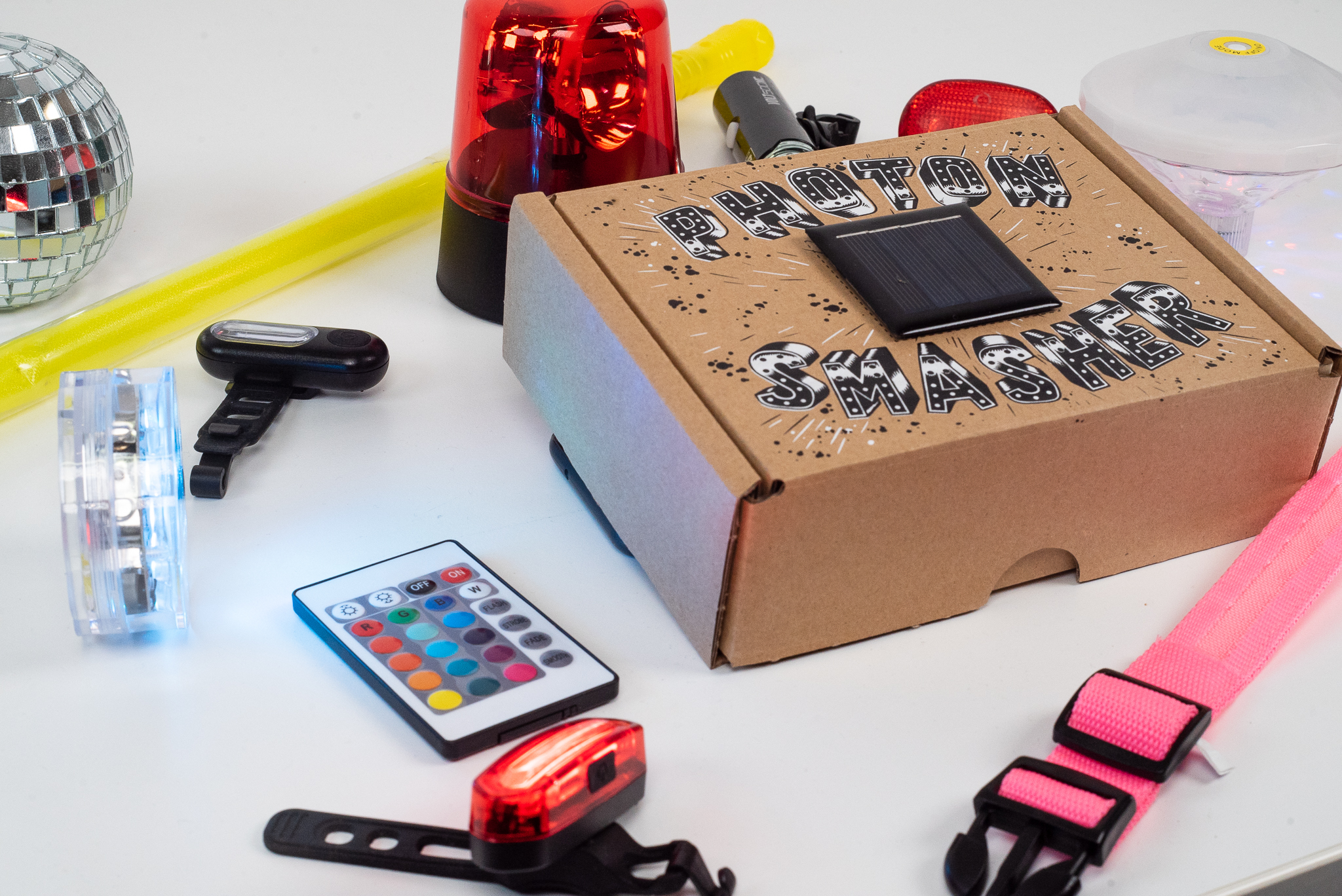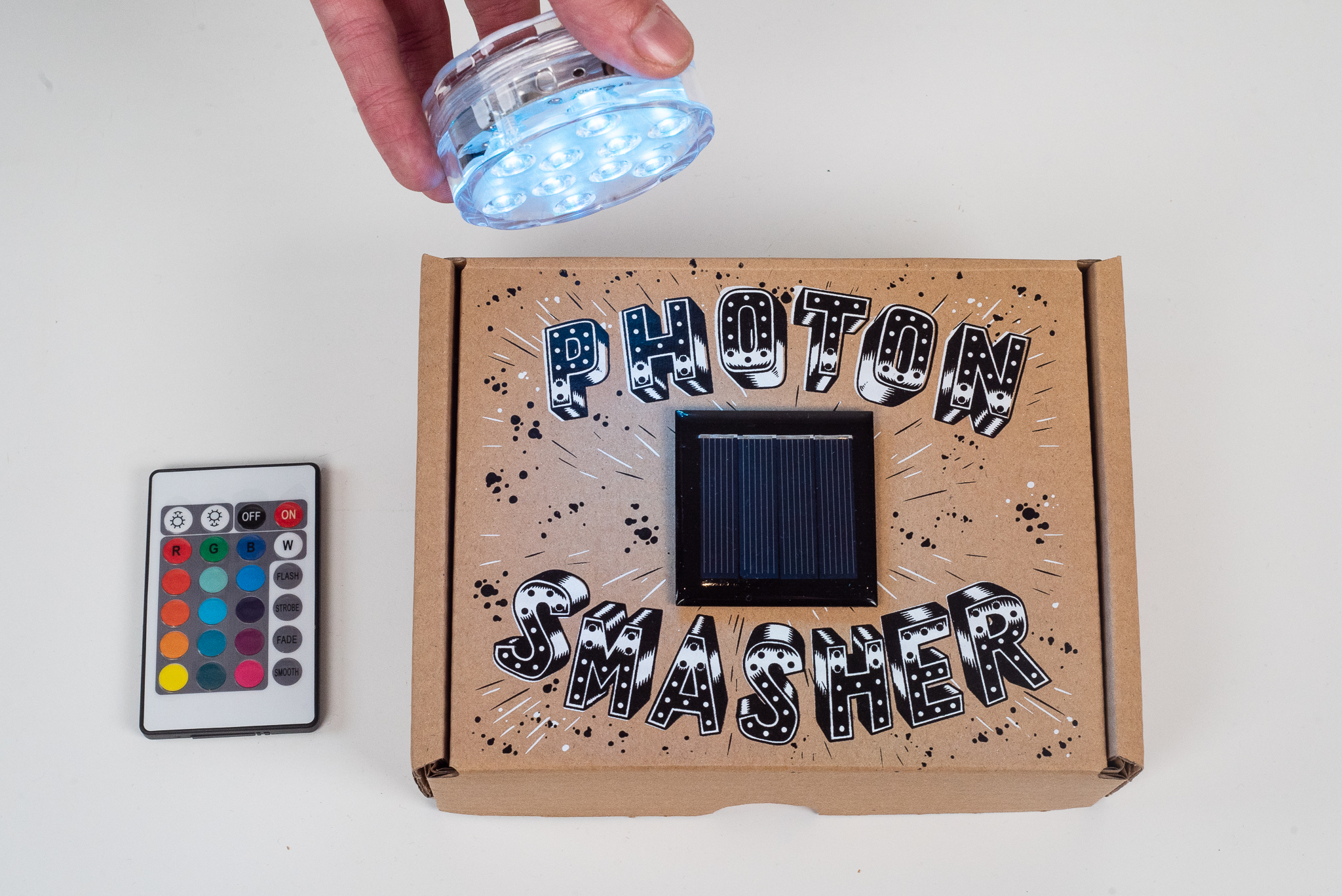Could you first introduce yourself to the reader?
My name is Frazer and I’m a sound artist, I’ve played a gig underwater, built an interactive musical tree and most recently the Photon Smasher – a microphone for listening to light!
So the Photon Smasher sounds pretty interesting! Could you give a high level overview of it?
The Photon Smasher turns light into sound. It uses a solar panel to turn light into an electrical signal which we can then hear through a speaker. What's great is the amazing sounds it unlocks, bicycle lights become drum beats and LEDs sound like futuristic synthesisers.
 Photon SmasherHow did the idea come about?
Photon SmasherHow did the idea come about?
Artist Loula Yorke was showing me how you can use LDRs (light dependant resistors) to use light to control sound, so a flash of light might turn something down or change the pitch. I then had the idea of listening to the light itself by connecting a solar panel directly to an amplifier, and the photon smasher was born!
And how did the Photon Smasher move from an idea into a physical product?
First off I had to learn how to make a PCB, or printed circuit board. This meant learning lots of new software and jargon. Myself and fellow founder of CLIP Simon Keep, then spent lots of time thinking about the packaging and branding to make it feel like a really special object to hold in your hand. We really love the fairground inspired artwork!
What were some (if any) of the learnings you took away from the experience of creating a physical product? Is there anything that surprised you, or that you’d do differently?
Triple check everything! When there's so many different things to manage it's really important to have lots of lists to make sure you’re not forgetting anything. Like when ordering components, or measuring the size of something to order in large quantities – one simple error can be expensive to fix if you’re ordering hundreds of them.
Music has a surprising overlap with physics anyway, but the Photon Smasher takes things to another level. Could you explain more of the science behind it? How do you convert light into sound?
A normal microphone converts sound into electricity. When sound waves hit a diaphragm this moves a coil of wire over a magnet, which produces electricity. A speaker is the reverse of this process. The Photon Smasher is a microphone for light, so instead of a diaphragm it uses a solar panel. When photons of light hit the solar panel it creates electricity through the photovoltaic effect. The different sounds it creates are due to pulse-width modulation (PWM). This is what light emitting diodes (LEDs) use to dim. PMW is when LEDs turn off and on at different rates, which we then hear as different pitches when amplified through a speaker.
The Photon Smasher is available to purchase online. What can someone expect if they were to buy it? Any top tips for getting started?
It comes with a big powerful LED which you can explore all the different settings and colours of light and hear the differences of. Put it in “flash” mode and use the speed setting to perform melodies! My favourite feature is when you combine it with a second flashing light, like a bicycle light or a strobe setting on your phone's flashlight. The flash cuts through the drone of the powerful light and you get a really cool rhythmic synth sound.
And where do the funds from purchases go?
All the money goes towards our music education projects in Colchester and North Essex, where we are running free workshops, creating learning resources and developing new instruments too.
You described the Photon Smasher as “our first ever instrument”. Could one interpret that to mean you have other ideas for experimental instruments in the future?
This version of the photon smasher is aimed at young people experimenting at home or in the classroom by using a built in speaker. The next version will be aimed at professional artists or performers – imagine a ping-pong bat with a solar panel in the middle and a cable coming off the handle. With this you could go to an arcade or fairground and record the lights there, or give it to a dancer and watch them perform sound by dancing around lights.
As a musician and artist whose practice is focused on experimentation and play, is the Photon Smasher something you anticipate building into your own work in the future?
I’m currently on the New Voices scheme with sound and music, a support program for composers to develop new ideas. My project will be developing this second version of the photon smasher and creating my own music and performances with it.
Where can people find out more and buy the Photon Smasher?
Head to our website to find out more www.clipsoundandmusic.uk/photonsmasher
And where can people find more of your work?
Head to my Instagram (@frazermerrick) to see my sound experiments or Spotify to listen to my music.









0 Comments